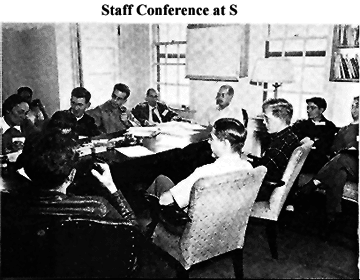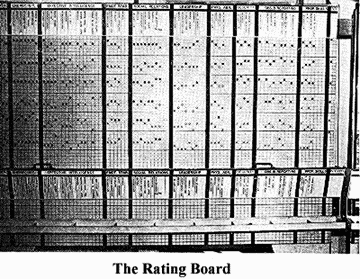
In World War II the Office
of Strategic Services was created to provide a variety of agents for special,
typically covert, tasks, including undercover activities, creation of propaganda,
translation, recruitment, radio operators, etc. etc. 
A number of psychologists were brought together for the purpose of assessing applicants for the varied and dangerous jobs the recruits would be asked to perform. The assessment task was made more difficult because the assessors could not get adequate job descriptions, the agents may be sent to do tasks different from the ones originally intended, and the shifting theaters of war may lead to a complete change in the situation to which the recruit was trained for and sent. Nevertheless, they persevered and created the first Assessment Center approach, a major tool used in industry today for assessing managers.
The candidates (including women) were brought together at Station S, an estate in the country. They were instructed to never reveal their true identities throughout the several days of their stay except during certain specific portions of the assessment. Those portions involved psychological tests similar to those used today (e.g., personal history forms, ability tests, personality measures, an interview etc). They were also asked to try to determine the true nature of their classmates throughout the weekend, to break their "stories."
Candidates were typically divided into subgroups for assessment activities:
Staff members observed them in a variety of assessment tasks and completed ratings on the candidates. They assumed that each assessment task was a sample of behavior and that it must only be interpreted in the context of the total sample of behavior across all the assessments. Among these tasks were:

Once all assessment procedures were complete, including a "graduation" party in which alcohol flowed and final efforts were made to "break" cover stories when all were relaxed, the team met to review candidates strengths and weaknesses and make recommendations. These recommendations took many forms as opposed to a simple in or out decision. A rating board was used to keep track of each candidate.
Among the psychologists who participated in the OSS selection procedures were:
Urie Bronfenbrenner, Donald Fiske, John Gardner, Clyde Kluckhohn, David Krech, David Levy, James G. Miller, O. H. Mowrer, Henry Murray, Theodore Newcomb, Donald MacKinnon, Harvey Robinson, Douglas Spencer; Nevid Stanfortt, Edward Tolman; Kurt Lewin.
References:
MacDonald, E. P. (1947). Undercover girl. NY: Macmillan Co.
Morgan, W. J. (1957). The O.S.S. and I. NY: Curtis Books.
Murphy, K. & Davidshofer, C. (1998). Psychological testing: Principles and applications, 4th Ed., Upper Saddle River, NJ: Prentice Hall.
OSS Assessment Staff. (1948). Assessment of men: Selection of personnel for the Office of Strategic Services. NY: Rinehart & Co.
Contact the author with comments or questions about this site by following the directions at this page (which will open in a new window.)
Website created: June 1996. Page Created: March, 1999. Last Modified: April 7, 2003.